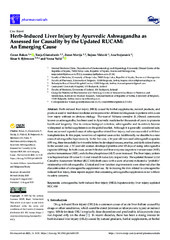Приказ основних података о документу
Herb-Induced Liver Injury by Ayurvedic Ashwagandha as Assessed for Causality by the Updated RUCAM: An Emerging Cause
| dc.creator | Bokan, Goran | |
| dc.creator | Glamočanin, Tanja | |
| dc.creator | Mavija, Zoran | |
| dc.creator | Vidović, Bojana | |
| dc.creator | Stojanović, Ana | |
| dc.creator | Björnsson, Einar S. | |
| dc.creator | Vučić, Vesna | |
| dc.date.accessioned | 2023-09-11T10:14:32Z | |
| dc.date.available | 2023-09-11T10:14:32Z | |
| dc.date.issued | 2023 | |
| dc.identifier.issn | 1424-8247 | |
| dc.identifier.uri | http://rimi.imi.bg.ac.rs/handle/123456789/1341 | |
| dc.description.abstract | Herb-induced liver injury (HILI) caused by herbal supplements, natural products, and products used in traditional medicine are important for differential diagnoses in patients with acute liver injury without an obvious etiology. The root of Withania somnifera (L.) Dunal, commonly known as ashwagandha, has been used in Ayurvedic medicine for thousands of years to promote health and longevity. Due to various biological activities, ashwagandha and its extracts became widespread as herbal supplements on the global market. Although it is generally considered safe, there are several reported cases of ashwagandha-related liver injury, and one case ended with liver transplantation. In this paper, we review all reported cases so far. Additionally, we describe two new cases of ashwagandha hepatotoxicity. In the first case, a 36-year-old man used ashwagandha capsules (450 mg, three times daily) for 6 months before he developed nausea, pruritus, and dark-colored urine. In the second case, a 30-year-old woman developed pruritus after 45 days of using ashwagandha capsules (450 mg). In both cases, serum bilirubin and liver enzymes (aspartate transaminase (AST), alanine transaminase (ALT), and alkaline phosphatase (ALP) were increased. The liver injury pattern was hepatocellular (R-value 11.1) and mixed (R-value 2.6), respectively. The updated Roussel Uclaf Causality Assessment Method (RUCAM) (both cases with a score of seven) indicated a “probable” relationship with ashwagandha. Clinical and liver function improvements were observed after the discontinuation of ashwagandha supplement use. By increasing the data related to ashwagandha-induced liver injury, these reports support that consuming ashwagandha supplements is not without its safety concerns. | |
| dc.language | English | |
| dc.publisher | Multidisciplinary Digital Publishing Institute (MDPI) | |
| dc.relation | COST Action CA17112—Prospective European Drug In-duced Liver Injury Network (ProEuroDILINet) | |
| dc.relation | info:eu-repo/grantAgreement/MESTD/inst-2020/200015/RS// | |
| dc.rights | openAccess | |
| dc.rights.uri | https://creativecommons.org/licenses/by/4.0/ | |
| dc.source | Pharmaceuticals | |
| dc.source | Pharmaceuticals | |
| dc.subject | ashwagandha | |
| dc.subject | herb-induced liver injury (HILI) | |
| dc.subject | hepatotoxicity | |
| dc.subject | liver injury | |
| dc.subject | updated RUCAM | |
| dc.title | Herb-Induced Liver Injury by Ayurvedic Ashwagandha as Assessed for Causality by the Updated RUCAM: An Emerging Cause | |
| dc.type | article | en |
| dc.rights.license | BY | |
| dc.citation.issue | 8 | |
| dc.citation.volume | 16 | |
| dc.identifier.doi | 10.3390/ph16081129 | |
| dc.identifier.fulltext | http://rimi.imi.bg.ac.rs/bitstream/id/3075/Herb-Induced_Liver_Injury_by_Ayurvedic_Ashwagandha_as_Assessed_pub_2023.pdf | |
| dc.type.version | publishedVersion |

